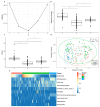Association of the Infant Gut Microbiome with Temperament at Nine Months of Age: A Michigan Cohort Study
- PMID: 38276199
- PMCID: PMC10821406
- DOI: 10.3390/microorganisms12010214
Association of the Infant Gut Microbiome with Temperament at Nine Months of Age: A Michigan Cohort Study
Abstract
Though studies in animals and humans link the gut microbiota to brain development and control of behavior, little research has examined this connection in healthy infants. This prospective study could determine associations between infant gut microbiota at 3 months, and infant temperament at 9 months, in a prospective pregnancy cohort (Michigan Archive for Research on Child Health; n = 159). Microbiota profiling with 16S rRNA gene sequencing was conducted on fecal samples obtained at 3 months of age. Based on the relative abundance of gut microbiotas, three groups were identified, and each group was characterized by different microbes. Infant temperament outcomes were reported by mothers using the Infant Behavior Questionnaire-Revised Very Short Form at a mean age of 9.4 months. Fully adjusted multivariate linear regression models showed that certain clusters were associated with higher negative emotionality scores, prominently among infants who had poor vitamin D intake. However, no associations were evident between gut microbiota clusters and temperament scales after FDR correction. After using three differential abundance tools, Firmicutes was associated with higher positive affect/surgency scores, whereas Clostridioides was associated with lower scores. An association between the gut microbiota and early infancy temperament was observed; thus, this study warrants replication, with a particular focus on vitamin D moderation.
Keywords: Bacteroides; diet; gut microbiota; infant; microbiome clustering; neurodevelopment; temperament; vitamin D.
Conflict of interest statement
The authors declare no conflict of interest.
Figures


Similar articles
-
Bacteroides-dominant gut microbiome of late infancy is associated with enhanced neurodevelopment.Gut Microbes. 2021 Jan-Dec;13(1):1-17. doi: 10.1080/19490976.2021.1930875. Gut Microbes. 2021. PMID: 34132157 Free PMC article.
-
Gut microbiota composition is associated with temperament traits in infants.Brain Behav Immun. 2019 Aug;80:849-858. doi: 10.1016/j.bbi.2019.05.035. Epub 2019 May 24. Brain Behav Immun. 2019. PMID: 31132457
-
Development of the infant gut microbiome predicts temperament across the first year of life.Dev Psychopathol. 2022 Dec;34(5):1914-1925. doi: 10.1017/S0954579421000456. Epub 2021 Jun 10. Dev Psychopathol. 2022. PMID: 34108055 Free PMC article.
-
Associations of maternal antenatal bonding with neonatal meconium microbiota and the behavior temperament of infants: A prospective longitudinal study.J Psychiatr Res. 2023 Jul;163:159-165. doi: 10.1016/j.jpsychires.2023.05.053. Epub 2023 May 16. J Psychiatr Res. 2023. PMID: 37210834
-
Dietary glycation compounds - implications for human health.Crit Rev Toxicol. 2024 Sep;54(8):485-617. doi: 10.1080/10408444.2024.2362985. Epub 2024 Aug 16. Crit Rev Toxicol. 2024. PMID: 39150724
Cited by
-
The effect of cesarean delivery on the neonatal gut microbiome in an under-resourced population in the Bronx, NY, USA.BMC Pediatr. 2024 Jul 13;24(1):450. doi: 10.1186/s12887-024-04908-7. BMC Pediatr. 2024. PMID: 38997672 Free PMC article.
References
Grants and funding
LinkOut - more resources
Full Text Sources

